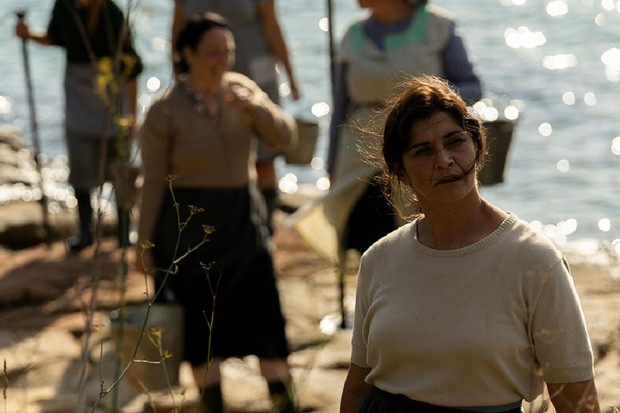Review: The Rye Horn

Jaione Camborda weaves a tale of motherhood, sisterhood and life-saving escape, which is elevated by the sensitivity she instils in every single detail
By Cristóbal Soage.
The Rye horn, the second film by Basque director Jaione Camborda, with which she is vying for the Golden Shell at the San Sebastián Film Festival for the first time, is a powerful and intimate drama that revolves around motherhood and women’s right to decide on matters regarding their body and their destiny. The movie whisks us away to the municipality of A Illa de Arousa in 1971. On this tiny Galician island, María is a shellfish catcher who also acts as a midwife for her neighbours. We see proof of María’s sensitivity and kindness towards her fellow women in an outstanding opening sequence, in which, for around ten minutes, we witness a woman giving birth, and Camborda’s camera captures the event with a thoughtfulness and tenderness seldom seen until now.
This keen eye for detail sets the tone of the entire film. The director shoots the characters while paying meticulous attention to their bodies and their movements, without at any point neglecting the importance of the surroundings in which they exist. María is shown as a strong and solitary woman who possesses an independence that was quite unusual in Spanish women during the latter years of the Franco regime. This strength is what leads her to make a commitment to ensuring the freedom of her fellow women, to the extent of making risky decisions with terrible repercussions that will forge her very destiny.
Forced to flee from the place where she has lived her entire life, she embarks on a journey from which there is no coming back, in order to cross the border to Portugal. For this desperate escape, María avails herself of a network of women who care for and protect her, from the neighbour who warns her that her life is in danger and that she has to run away, to the prostitute (played by incredible first-timer Siobhan Fernándes) who takes her in with open arms once she reaches her destination. During her voyage, we follow the protagonist with a level of interest that never dwindles, mostly thanks to the sterling work of debutante Janet Novás, who capitalises on her experience as a dancer to endow her character with an impressive physical expressiveness.
As the film goes on, we see a succession of memorable scenes in which the cinematography by Rui Poças captures the sheer beauty of the surroundings with incredible sobriety. To give the movie the truthful dimension that it undeniably possesses, the work of Melania Freire, as art director, and Uxía Vaello, as costume designer, is also key. In this way, places such as the furancho (something akin to a pub in a private residence), the shellfish processing plant and the houses that harbour the protagonist take on a life of their own, and they give clear signs of how respectfully the film deals with the lives and the spaces it portrays. Indeed, they are lives and spaces that have not been shown on the big screen very often, and they get their sweet revenge for this thanks to the splendour of The Rye Horn.
The Rye Horn is a production by Spanish outfits Esnatu Zinema, Miramemira and Elastica Films, together with Portugal’s Bando à Parte and Belgium’s Bulletproof Cupid. Its international sales are taken care of by Films Boutique.


